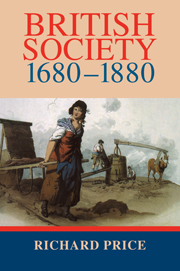Book contents
- Frontmatter
- Contents
- Preface
- Acknowledgments
- Introduction: beginnings, periods and problems
- 1 The economy of manufacture
- 2 A universal merchant to the world: the political economy of commerce and finance
- 3 The ambiguities of free trade
- 4 The reach of the state: taxation
- 5 The age of localism
- 6 The public, the private and the state: civil society 1680–1880
- 7 Exclusion and inclusion: the political consequences of 1688
- 8 Exclusion and inclusion: defending the politics of finality 1832–1885
- 9 The stabilities and instabilities of elite authority: social relations c.1688–c.1880
- Afterword
- Index
6 - The public, the private and the state: civil society 1680–1880
Published online by Cambridge University Press: 02 December 2009
- Frontmatter
- Contents
- Preface
- Acknowledgments
- Introduction: beginnings, periods and problems
- 1 The economy of manufacture
- 2 A universal merchant to the world: the political economy of commerce and finance
- 3 The ambiguities of free trade
- 4 The reach of the state: taxation
- 5 The age of localism
- 6 The public, the private and the state: civil society 1680–1880
- 7 Exclusion and inclusion: the political consequences of 1688
- 8 Exclusion and inclusion: defending the politics of finality 1832–1885
- 9 The stabilities and instabilities of elite authority: social relations c.1688–c.1880
- Afterword
- Index
Summary
Origins and definition
Civil society is that domain in which public activities of a collective and individual kind may be freely enacted. Civil society is bounded on one side by the jurisdiction of the state and on the other side by the private world of the individual. The kinds of institutions that fill the spaces, define the character and determine the values of civil society vary over different historical periods. Similarly, the relationship between the formal structures of the state, the public world of civil society and the intimate world of the individual will vary over time and place. Understanding the dynamics of civil society in any period requires appreciating the arrangements that govern the relationships between three elements: the institutional state, the public world of civil society and the private world of the individual.
Before the seventeenth century, there was no concept of the “public” as the core of civil society. There was the court, the Lords and an occasional Parliament, and then there were the people. No legitimate space existed for public associations of private individuals. Over the course of the century the role of the court and of Parliament were transformed. Functional specialization between the political, cultural and economic sectors created a public sphere. By the end of the seventeenth century, the contours of a public sphere were drawn by a greatly expanded associational life. This was primarily an urban phenomenon. Institutions like the coffee shops, the newspapers, the pamphlet literature and various political associations provided the seedbeds for the development and expression of public opinion. Bodies such as charities, theaters, assembly rooms and voluntary hospitals expressed the civic responsibilities of individuals within the public sphere.
- Type
- Chapter
- Information
- British Society 1680–1880Dynamism, Containment and Change, pp. 192 - 233Publisher: Cambridge University PressPrint publication year: 1999



